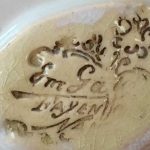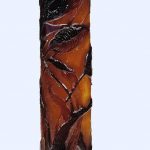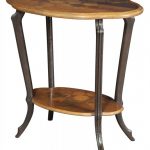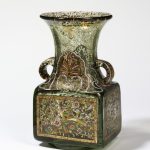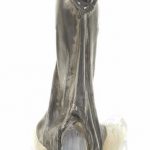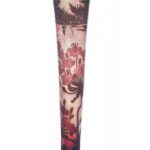Emile Gallé was a leading Art Nouveau maker renowned for his glass work and was thought to be one of the leading forces of the Art Nouveau movement.
Emile Gallé was the son of a faience and furniture manufacturer, so it is not surprising that Emile Gallé was also known to have created faience objects as well, in particular his faience cats.
His early work was executed using clear glass decorated with enamel, but he soon turned to an original style featuring heavy, opaque glass carved or etched with plant motifs, often in two or more colours as cameo glass.
Below are some examples and price guides of Emile Gallé’s works including examples of his maker’s marks and an Art Nouveau carved and inlaid side table.
Emile Gallé Makers Mark
EMILE GALLE VASE, CIRCA 1900 Glass, internally streaked, triple overlaid, acid-etched with flowering foliage and fire-polished 11¼ in. (23.5 cm.) high cameo Gallé
Sold for GBP 5,250 at Christie’s in 2010
Emile Gallé Art Nouveau Carved and Marquetry Inlaid Fruitwood Two Tier Side Table Circa 1905, signed in marquetry Shaped oval top and shelf stretcher inlaid with flowers and butterflies, on shaped legs. Height 30 1/2 inches, width 32 inches, depth 20 1/2 inches.
Sold for $812 (includes buyer’s premium) at Doyle in 2020
At the Paris 1889 exhibition, Gallé’s display was awarded a Grand Prix. The complex enamelling and gilding of the vase shown (Fig 1) is typical of Gallé’s interest in technique, but the design – perhaps derived from Persian lacquerwork – is very different from his later and better known Art Nouveau glassware. Reference: Victoria and Albert Museum.
Within a decade of another successful showing at the Paris Exhibition of 1889, Gallé had reached international fame and his style, with its emphasis on naturalism and floral motifs, was at the forefront of the emerging Art Nouveau movement.
He continued to incorporate experimental techniques into his work, such as metallic foils and air bubbles, and also revitalized the glass industry by establishing a workshop to mass-produce his, and other artists’, designs. The factory would employ 300 workers and artisans at its height, including the notable glassmaker Eugène Rosseau, and remained in operation until 1936.
In 1901, together with Victor Prouvé, Louis Majorelle, Antonin Daum and Eugène Vallin, he founded an Art Nouveau movement known as École de Nancy (The Nancy School). Many of Gallé works are kept at the Musée de l’École de Nancy. Reference: Wikipedia
